Fish |
|
Tiger Rockfish |
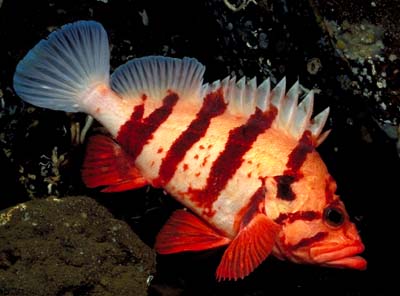 This photo of a Tiger Rock fish was taken at Repulse Rock (White Lady) which is in the Saanich Inlet. The rock fish was at about 130 feet deep and the visibility was very good at that depth. These fish are very shy and it is usually very difficult to get close enough to take a good picture.
This photo of a Tiger Rock fish was taken at Repulse Rock (White Lady) which is in the Saanich Inlet. The rock fish was at about 130 feet deep and the visibility was very good at that depth. These fish are very shy and it is usually very difficult to get close enough to take a good picture. |
|
Canary Rockfish |
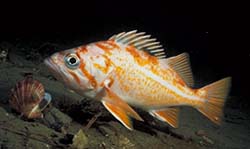 This photo of a Canary Rock fish was taken at Ogden Point (The Breakwater) in Victoria. These beautifully
colored rockfish and not very common.
This photo of a Canary Rock fish was taken at Ogden Point (The Breakwater) in Victoria. These beautifully
colored rockfish and not very common. |
|
Grunt Sculpin |
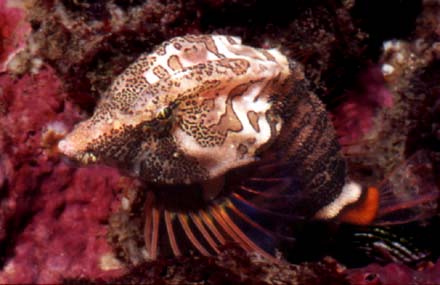
This stubby little guy only grows to a couple of about 5 cms. (2 inches) maximum length. They don't really
swim; what they do more resembles walking along the bottom. They are very slow but are still often hard to find. This picture was taken at Ten Mile Point in Victoria. |
|
Kelp Greenlings |
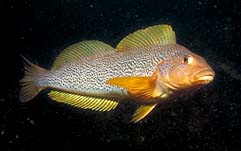 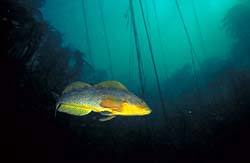 These colorful fish are often fed by divers and can be very photogenic.
These colorful fish are often fed by divers and can be very photogenic.
|
|
|
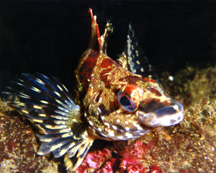
The peculiar body shape and bright red
colors make these fish very photogenic. I found this one at Octopus Point which is located in Sansum Narrows.
|
|
Wolf Eels |
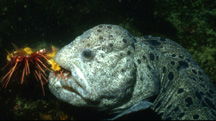 Wolf Eels, despite their name, are not actually eels, they are fish. This male wolf eel lives at Tozier Rock in the Saanich Inlet. A wolf eel's diet consists mainly of shellfish including crabs and urchins. Wolf eels can grow to a little over two meters (six feet). The males are lighter in
color and have large, bulbous, wrinkly heads. The females have a smaller head, a more streamline appearance and are slightly darker.
Wolf Eels, despite their name, are not actually eels, they are fish. This male wolf eel lives at Tozier Rock in the Saanich Inlet. A wolf eel's diet consists mainly of shellfish including crabs and urchins. Wolf eels can grow to a little over two meters (six feet). The males are lighter in
color and have large, bulbous, wrinkly heads. The females have a smaller head, a more streamline appearance and are slightly darker.
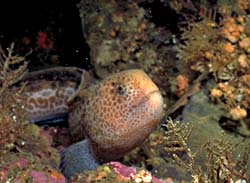
Many wolf eels that live near common dive sites have become almost tame. This is not necessarily a good thing. So called tame wolf eels have approached divers in an aggressive manner. This can be very unnerving for someone not familiar with these animals. These wolf eels are not tame, they are conditioned and are still wild animals, despite their Muppet-like appearance. |
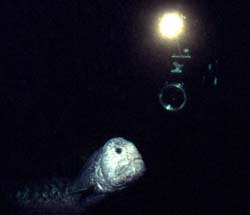
Top Left: Wolf eel at Tozier rockAbove Right: Juvenile wolf eel. Left: Video being taken of wolf eel at McKenzie Bight. |
|
Cabezon |
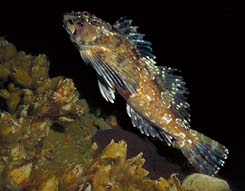 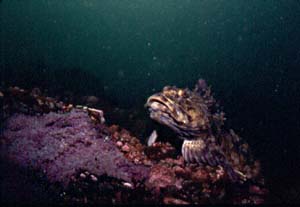 Cabezon have large heads especially when they grow to their maximum size of one metre (over three feet) long
Cabezon have large heads especially when they grow to their maximum size of one metre (over three feet) long Left: Photo taken at Ten Mile Point Right: Cabezon guarding eggs at North Cod Reef. (The purple patch in the bottom left are the eggs.)
|
|
Red Irish Lord |
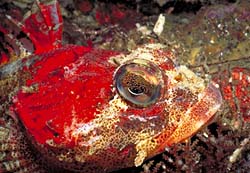 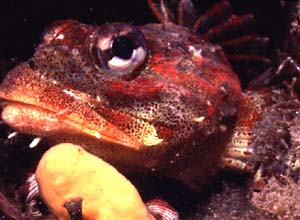 Coloration can vary a lot in this species, but most have at least some red.
Coloration can vary a lot in this species, but most have at least some red.
|
|
Ling Cod |
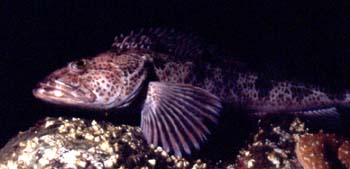 The male of this species will aggressively ward off any intruders; including divers. Ling Cod can grow to 1.5 metres (5 feet) and weigh up to 32 kgs. (70 lbs.). Ling Cod have long been a
spear fisherman's favorite target. They are not skittish and you can almost touch them underwater. For this same reason they make great photographic subjects.
The male of this species will aggressively ward off any intruders; including divers. Ling Cod can grow to 1.5 metres (5 feet) and weigh up to 32 kgs. (70 lbs.). Ling Cod have long been a
spear fisherman's favorite target. They are not skittish and you can almost touch them underwater. For this same reason they make great photographic subjects.
|
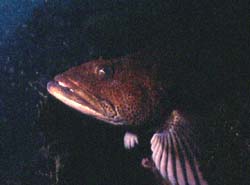 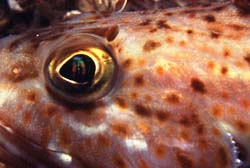 Top Right: Average ling cod. Top Right: Average ling cod.Right: Close-up of ling cod. Left: Head of a very large ling cod taken at Ogden Point (The Breakwater) in Victoria. |
|
Spotted Rat Fish |
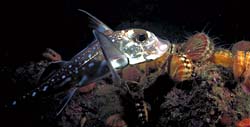 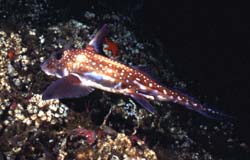 These absurd looking fish are nocturnal. So while out doing a night dive it is very common to see them. They are attracted to divers' lights and will swim right into them. Their
spiny dorsal fins are poisonous which and can be harmful to humans, but not fatal.
These absurd looking fish are nocturnal. So while out doing a night dive it is very common to see them. They are attracted to divers' lights and will swim right into them. Their
spiny dorsal fins are poisonous which and can be harmful to humans, but not fatal.
|
|
Longfin Sculpin
|
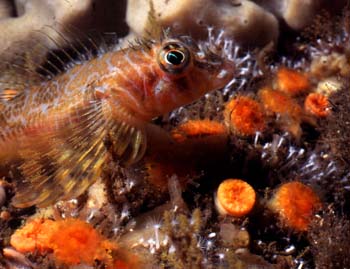 This little guy was hiding amongst assorted invertebrates. He blends in really
well in order to avoid being some other fish's lunch.
This little guy was hiding amongst assorted invertebrates. He blends in really
well in order to avoid being some other fish's lunch.
|
|

 This photo of a Tiger Rock fish was taken at Repulse Rock (White Lady) which is in the Saanich Inlet. The rock fish was at about 130 feet deep and the visibility was very good at that depth. These fish are very shy and it is usually very difficult to get close enough to take a good picture.
This photo of a Tiger Rock fish was taken at Repulse Rock (White Lady) which is in the Saanich Inlet. The rock fish was at about 130 feet deep and the visibility was very good at that depth. These fish are very shy and it is usually very difficult to get close enough to take a good picture. This photo of a Canary Rock fish was taken at Ogden Point (The Breakwater) in Victoria. These beautifully
colored rockfish and not very common.
This photo of a Canary Rock fish was taken at Ogden Point (The Breakwater) in Victoria. These beautifully
colored rockfish and not very common.

 These colorful fish are often fed by divers and can be very photogenic.
These colorful fish are often fed by divers and can be very photogenic.

 Wolf Eels, despite their name, are not actually eels, they are fish. This male wolf eel lives at Tozier Rock in the Saanich Inlet. A wolf eel's diet consists mainly of shellfish including crabs and urchins. Wolf eels can grow to a little over two meters (six feet). The males are lighter in
color and have large, bulbous, wrinkly heads. The females have a smaller head, a more streamline appearance and are slightly darker.
Wolf Eels, despite their name, are not actually eels, they are fish. This male wolf eel lives at Tozier Rock in the Saanich Inlet. A wolf eel's diet consists mainly of shellfish including crabs and urchins. Wolf eels can grow to a little over two meters (six feet). The males are lighter in
color and have large, bulbous, wrinkly heads. The females have a smaller head, a more streamline appearance and are slightly darker.



 Cabezon have large heads especially when they grow to their maximum size of one metre (over three feet) long
Cabezon have large heads especially when they grow to their maximum size of one metre (over three feet) long 
 Coloration can vary a lot in this species, but most have at least some red.
Coloration can vary a lot in this species, but most have at least some red.
 The male of this species will aggressively ward off any intruders; including divers. Ling Cod can grow to 1.5 metres (5 feet) and weigh up to 32 kgs. (70 lbs.). Ling Cod have long been a
spear fisherman's favorite target. They are not skittish and you can almost touch them underwater. For this same reason they make great photographic subjects.
The male of this species will aggressively ward off any intruders; including divers. Ling Cod can grow to 1.5 metres (5 feet) and weigh up to 32 kgs. (70 lbs.). Ling Cod have long been a
spear fisherman's favorite target. They are not skittish and you can almost touch them underwater. For this same reason they make great photographic subjects. 
 Top Right: Average ling cod.
Top Right: Average ling cod.
 These absurd looking fish are nocturnal. So while out doing a night dive it is very common to see them. They are attracted to divers' lights and will swim right into them. Their
spiny dorsal fins are poisonous which and can be harmful to humans, but not fatal.
These absurd looking fish are nocturnal. So while out doing a night dive it is very common to see them. They are attracted to divers' lights and will swim right into them. Their
spiny dorsal fins are poisonous which and can be harmful to humans, but not fatal.
 This little guy was hiding amongst assorted invertebrates. He blends in really
well in order to avoid being some other fish's lunch.
This little guy was hiding amongst assorted invertebrates. He blends in really
well in order to avoid being some other fish's lunch.